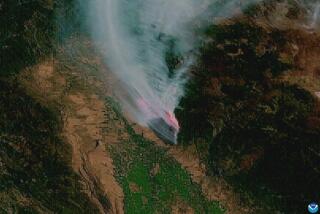Amazing NASA video shows the sun erupting in unprecedented detail
Youâve never seen a solar eruption video quite like this before.
After 11 months in space, NASAâs Interface Region Imaging Spectrograph (IRIS) has captured video of a coronal mass ejection in unprecedented detail, and the results are spectacular.
And while you watch the video, keep this dazzling detail in mind: The field of view for this imagery is five Earths wide and about seven and a half Earths tall, according to a NASA release.
A coronal mass ejection is usually associated with a solar flare, but while a solar flare is like a flash of light, a coronal mass ejection is more like a volcanic eruption that sends material from the sun rocketing off its surface.
In the video above, that material is jetting away from the sun at the speed of 1.5 million mph.
When a CME is directed to the Earth it can mess with our satellites and our power grid. However, this particular CME went shooting off toward Venus instead.
Bart De Pontieu, the IRIS science lead at Lockheed Martin Solar & Astrophysics Laboratory in Palo Alto, said he and his team have been wanting to capture data from a CME for a while now, but it isnât so easy.
While other solar telescopes look at the entire sphere of the sun, IRIS can only see small pieces of it at a time.
âIRIS is a telescope, but it kind of acts like a microscope,â he told the Los Angeles Times. âIt sees a smaller part of the sun, but it has a much higher resolution.â
The science team can make informed guesses about where something interesting on the sun will occur, but they also have to get a little lucky.
âWe have a pretty small field of view and the sun has to cooperate,â De Pontieu said.
IRIS was designed to study a thin layer of the sun known as the interface region that lies between the surface of the sun and its upper atmosphere, known as the corona. Scientists are hoping that by peering closely into this little-studied zone, they will get to the bottom of what is known as âthe solar corona mystery.â
In the rest of the sun, the further away you get from the core, the cooler the temperature. However something strange happens between the surface of the sun and its atmosphere. Suddenly, the temperatures get a lot hotter. When the surface of the sun is 6,000 degrees Kelvin, the corona might be more than 1 million degrees Kelvin.
So what is heating up all that material as it rises from the sunâs surface to its atmosphere? That is what scientists hope to find out.
De Pontieu said he and his team have already learned a lot about the different layers of the sun and how they interact from IRIS, and said they will be publishing their results soon.
âIâm sorry I canât say more right now,â he said, âbut I will say we are amazed at how violent of a place this region is.â







